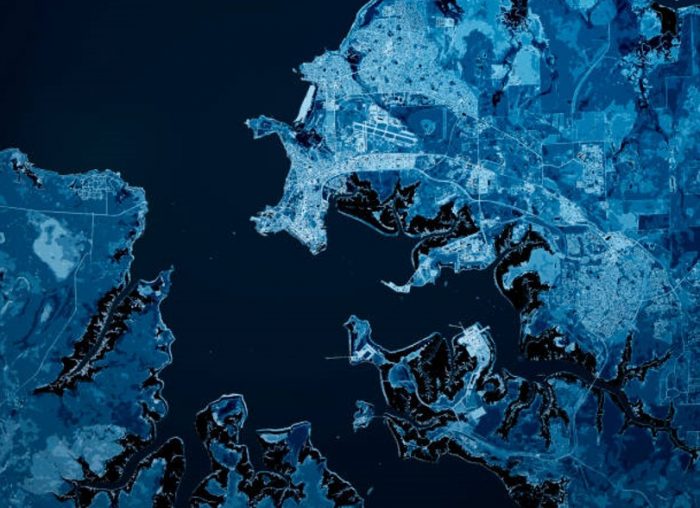
Darwin Harbour and the port facilities along its eastern arm have a long history of disregard, disrepair and haphazard investment and control by successive governments dating back to the close of World War II. There has arguably never been anything like a coherent national security or economic strategy for Australia’s most northern and strategically important deepwater port.
This remains the case today, despite it being critical infrastructure for the current and future economic and social prosperity of the Northern Territory.
Until 2015, the NT government faced a dual problem: funding the port’s operations and investing for its future maintenance and development. Despite repeated efforts, the government was unable to find assistance to resolve either problem. Following a global trend, a long-term lease of part of the port seemed to make good economic sense. The lease was won by a Chinese-owned company, Landbridge Infrastructure Australia. At that time, most in Canberra were working under the assumption that a red line separated economic and national security policies.
The distinct change in the global strategic environment since then has made the lease a concern from a national security perspective.
The key question that any future strategy for Darwin Harbour must now address is how can our most northern deepwater port best be used in an environment in which the Chinese party-state and military are aggressively pursuing interests vastly different from our own? The answer lies in understanding what role Darwin can play as Australia works with allies and partners to evoke positive contributions to regional security and credible deterrence of conflict.
National security doves continue to protest that China isn’t an expansionist power. However, even the most strident acknowledge that the global security context continues to experience more significant uncertainty and unpredictability. In
comments made to the Chinese state-owned news agency Xinhua, Landbridge’s owner, Ye Cheng, said of the port, ‘This is our involvement in One Belt, One Road.’ Ye Cheng’s admission suggests that there’s a connection between Landbridge’s port lease and the Belt and Road Initiative.
Meanwhile, as the gateway for maritime trade to Asia, Darwin Port’s renewed significance since Covid-19 has shown that national supply-chain resilience and sovereignty have an all-new level of policy importance.
Today, everyone has a plan for the port—the NT government, the Department of Defence, the US government, the Japanese oil company Inpex, Landbridge and the broader private sector. Better still, many of those plans have very real budgets. For example, the US is planning to spend more than $80 million on liquid-fuel storage. But too little has been done to align those often ambitious visions, and uncertainty about the future of the port lease adds further confusion.
Our new ASPI report,
Lead me to the harbour! Plotting Darwin Harbour’s future course, launched today, aims to move beyond binary options playing out in public policy discourse. Instead, we offer an analysis of the benefits provided by both the port and the harbour, exploring the harbour’s history, the nature of its strategic importance to Australia and our allies, and opportunities for its future development. We explore four options for the future development of the port and harbour. Rather than examining the policy behind the current leasing arrangements, this work focuses on promoting policy discourse on a unifying vision for the harbour’s future.
A key insight is that this is an opportunity for the federal government to work with the NT government to harness the existing plans for the port, or at least those proposed by Defence, the US government and the NT government, and embed those plans within the broader strategic vision for Australia. While each of those worthy projects will undoubtedly have merit, the question is whether, by carefully harnessing them together, they could produce a greater economic and national security whole.
Australia’s economic and political relationships and opportunities with neighbours in Asia, the increased aggression of the Chinese Communist Party, and the US force posture pivot to the Indo-Pacific, all put northern Australia at the centre of the region rather than the edge of Australia.
The four opportunities we explore for the future of the port each has its strengths and weaknesses. The two things they all share are a need to mitigate the security implications of the current lease arrangement in the era of great-power competition and a need to invest considerable money into any of the proposed solutions for the chosen option to be successful beyond the short term.
Other key reference points for decision-making include the policy directions we can see being taken by our major security partners: the US, Japan and now India as a member of the Quadrilateral Security Dialogue.
Darwin’s future port must be a national strategic and economic asset, invested in to enable greatly increased Australian, ally and partner military operations and supporting Australia’s economic and trade relations with Southeast, West and North Asia. A partnership between the federal and NT governments that uses Defence as an anchor tenant in developing the port as a primary naval asset for Australia and our strategic partners is the essential starting point. That will also enable new corporate investment and activity—but only if the two governments work together with a strategic and economic focus on the port and its future.
This time around, big thinking and a long-term view are required. Getting Darwin Harbour right will take real vision, leadership, collaboration and investment, and all in spades.
Our recommendation is that it’s now time for a national discussion on the port’s role in the long-term strategic future of Australia. That national discussion must result in the production of a national security and economic strategy for the port and harbour with appropriate funding attached.
 Print This Post
Print This Post